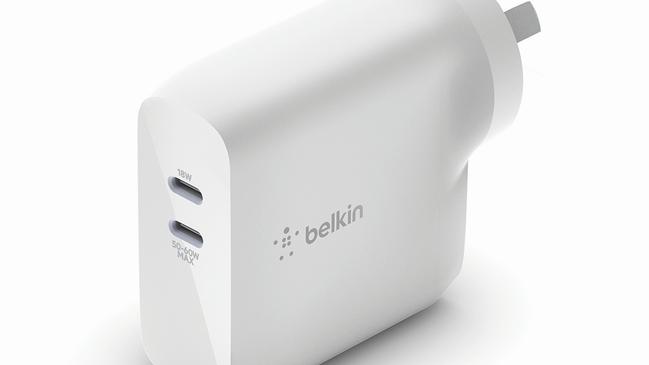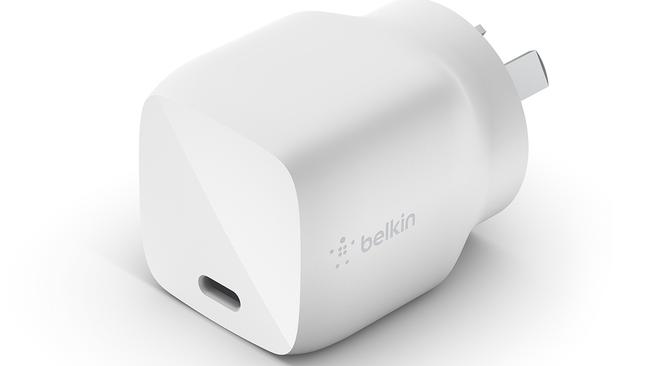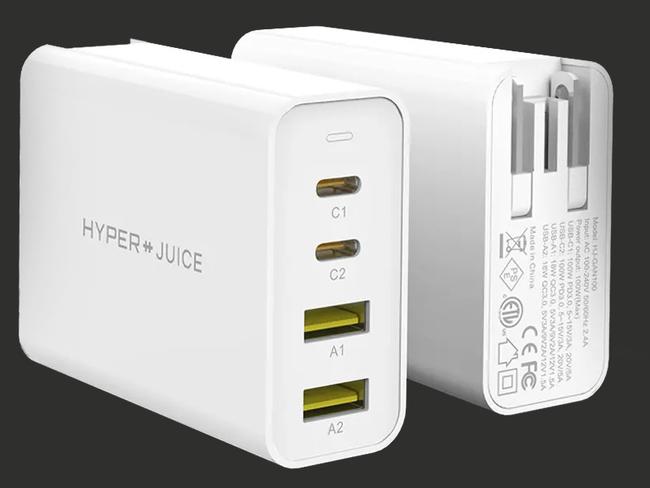Belkin is among the first with GaN chargers in Australia
GaN chargers which are radically smaller are now in the Australian market.

Brothers and sisters, the revolution is here. No, not THAT revolution. This is the revolution in how we charge our phones, tablets and laptops. Unfurl the flag, raise the anthem, stand to attention. It’s happening now. This is thanks to the magic substance, gallium nitride.
First, the device chargers that we plug into wall sockets and power boards are becoming much smaller. In fact, you can buy one now.
Number two. Because chargers are smaller, there’s no excuse for them hogging two adjacent sockets on a powerboard. If your powerboard has eight spots, you should connect eight devices – potentially many more.
Number three. Those big power bricks that we carry around to charge a laptop should soon become extinct. In particular, carrying around a sleek, lightweight, sub-kilogram laptop powered by a dirty big heavy charging brick should be a contradiction you bear no more.
During my chemistry classes at school, I never gave much thought to gallium which is number 31 on the chemical elements periodic table, but it’s growingly important now.
Gallium is a soft metal and it’s certainly not something you’d build your house frame with.
If you somehow managed to, the next time the mercury hit 29.76C on a moderately warm day, you’d find your gallium home reduced to a blob of metal in the street. You see, the temperature 29.76C is the melting point of gallium. You can pick up a piece of gallium as metal, and watch it melt in your hand.

Gallium is reasonably plentiful but it’s not found as a metal, it’s more in bauxite and compounds such as zinc oxides. In electronics, gallium compounds have proven to be a great conductor of electricity and heat, and as well as being a semiconductor, gallium nitride (aka GaN) is a component of LEDs with a future in power electronics. It has been dubbed “the new silicon” but it’s proven hard to work with in manufacturing and many say it’s a case of don’t hold your breath.
Nevertheless, researchers have successfully turned to using GaN as a replacement for silicon in chargers and finally there is fruit on the apple tree. Chargers can be a lot smaller and more efficient, and they support fast charging.
The timing is perfect, because simultaneously manufacturers are including USB-C charging ports on phones, tablets and laptops. Instead of using a power brick, you use a small, compact, high wattage GaN charger with a USB-C connector.
Several manufacturers are already bringing GaN chargers to market, one being US consumer electronics firm Belkin.
I’ve been using two products available in Australia. One is a 30 Watt GaN charger ($64.95), the other has two USB-C slots for charging a 60W device and 18 Watt device simultaneously ($89.95). The size difference is remarkable. The 30W GaN charger is already smaller than a 10W standard Apple charger I have.
These charger plugs are a forerunner to something you will soon see – a single plugged-in GaN charger with four or six sockets that charge a multitude of devices without needing a powerboard at all.
I’ve been chatting Belkin’s senior product manager Norbert von Boode to find out which chargers suit particular devices. How can consumers learn to choose the GaN charger with the optimal power rating?

The first way is to go to the manufacturer’s site and look up the rating in watts and volts and look for a GaN charger with a similar or slightly higher rating.
Apple for example has a support page that lists the power adaptor rates for different device models. They range from 5W adaptors for iPhones up to iPhone 11, to 10W, 12W, 18W and 20W adaptors for different iPad versions. Mr von Boode says you might go up to 30 watts of an iPad based on Belkin’s internal testing.
MacBook chargers typically are 30W (Air, lighter versions), or 60W, 87W and 90W for the latest 16-inch MacBook Pros. See here.
GaN chargers also support fast charging, but the degree of fast charging is limited by the device’s capability.
You’d want to choose a GaN power delivery charger with a power (watt) rating no less than the manufacturer’s. He says Belkin’s 60W/18W dual socket charger should work well for many consumers charging an iPhone and laptop simultaneously. They’d need only carry one charger.
Samsung phones have a 25 watt charger so you’d look for a GaN equivalent or a close fit, for example 30 watts.
The other way of establishing the power you need is to read the output power rating on a device’s existing charger and not go below that with a GaN substitute. Some chargers display the watt rating, others give current and voltage, which you multiply to get a watt rating. You probably will need a good light and magnifying glass to see these power ratings on the plug.
He says Belkin has a knowledge centre page with information on various power profiles.

Mr von Boode says companies could choose to either keep making the chargers smaller, or keep the same dimensions and make charging even faster. “Many people are choosing to go the former,” he says.
He says GaN chargers may become even smaller and slimmer a year or two from now. He says the new chargers currently use older design components meant for silicon and new designs will see GaN chargers “really come to full synergy”.
He acknowledges these chargers are relatively expensive but that should change. “As more factories and manufacturers figure out how to leverage GaN, the cost will come down significantly, If not even to the equal of non-GaN chargers.”
Belkin isn’t the only show in town. Hyper has a 100W GaN charger with four ports – two 100W USB-C and two 18 W USB-A ports. It costs $US100 ($141) and you can get it with Australian pin converters. There’s lots of options if you search online.
Whatever the case, you can soon cut back on the army of chargers you need, which will be especially useful on the road.


